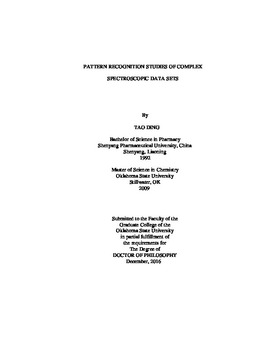| dc.contributor.advisor | Lavine, Barry K. | |
| dc.contributor.author | Ding, Tao | |
| dc.date.accessioned | 2018-06-29T14:32:28Z | |
| dc.date.available | 2018-06-29T14:32:28Z | |
| dc.date.issued | 2016-12 | |
| dc.identifier.uri | https://hdl.handle.net/11244/300336 | |
| dc.description.abstract | Profiling of complex samples using spectroscopic techniques continues to be an active area of research with a large and burgeoning literature. The overall goal of profile analysis is to correlate a characteristic fingerprint pattern in a spectrum with the properties of a sample or in biomedical studies with the presence or absence of disease in a patient or animal from which the sample was taken. Fingerprinting experiments of this type often yield profiles containing hundreds of constituents. Multivariate statistical and pattern recognition techniques can be effective methods for the analysis of such complex data. However, the classification of complex samples on the basis of their spectroscopic profiles is complicated by several factors: (1) confounding of the desired group information by experimental variables or other systematic variations in the data, and (2) the presence of noisy data and irrelevant variables that unnecessarily enlarge the data space and the complexity of the classification model developed from the data, an effect that tends to increase both the error rate and to reduce robustness of data-driven predictions. Several interesting projects involving these effects and methods for dealing with them are highlighted in this dissertation. In one study, the identification of N-linked glycan biomarkers in serum samples measured by MALDI-IMSMS and analyzed by pattern recognition techniques to screen a population at risk for esophageal adenocarcinoma (EAC) is discussed. In another study, search prefilters were developed as part of a prototype pattern recognition library search system to facilitate searching of infrared spectra in the Paint Data Query database and to improve discrimination capability for automotive paint comparisons involving the original equipment manufacturer. A genetic algorithm for variable selection to improve classifications was used in both of these studies. The approach taken by the genetic algorithm for pattern recognition relies heavily on graphics for the presentation of results. | |
| dc.format | application/pdf | |
| dc.language | en_US | |
| dc.rights | Copyright is held by the author who has granted the Oklahoma State University Library the non-exclusive right to share this material in its institutional repository. Contact Digital Library Services at lib-dls@okstate.edu or 405-744-9161 for the permission policy on the use, reproduction or distribution of this material. | |
| dc.title | Pattern recognition studies of complex spectroscopic data sets | |
| dc.contributor.committeeMember | Gelder, John | |
| dc.contributor.committeeMember | El Rassi, Ziad | |
| dc.contributor.committeeMember | Krishnan, Sadagopan | |
| dc.contributor.committeeMember | Zhou, Donghua | |
| osu.filename | Ding_okstate_0664D_14972.pdf | |
| osu.accesstype | Open Access | |
| dc.type.genre | Dissertation | |
| dc.type.material | Text | |
| thesis.degree.discipline | Chemistry | |
| thesis.degree.grantor | Oklahoma State University | |
